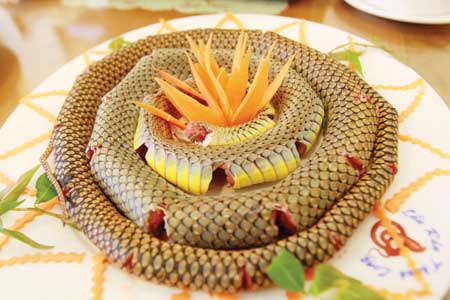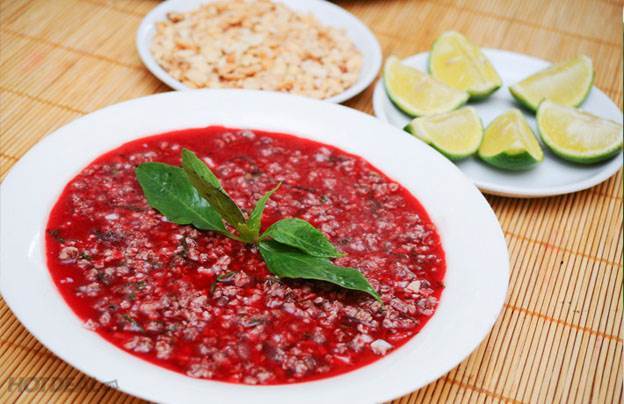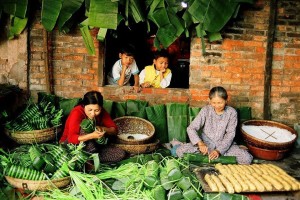Vietnamese Cuisine
Vietnamese cuisine explanation. The reason why Vietnamese foods taste so good and Various!
-- In general
Vietnam is an agricultural country belonging to the tropical region, tropical monsoon. In addition, the territory of Vietnam is divided into three distinct regions: North, Central, and South. The geographical, cultural, ethnic and climatic characteristics that regulate the specific characteristics of regional cuisine. Each region has a characteristic taste. That contributes to rich and varied Vietnamese cuisine. This is a food culinary that uses a variety of vegetables (boiled, fried, pickled, raw); Many types of soup, especially sour soup, while the number of foods with animal nutrition is usually less than vegetables. The most common types of meat are pork, beef, chicken, duck, duck, shrimp, fish, crab, snails, mussels, oysters, etc. Foods made from less common meats such as dog meat, goat meat, turtle meat, snake meat, turkey meat ... are often not the main sources of meat and are sometimes considered specialties. Use on a certain occasion with alcohol. Vietnamese also have a number of vegetarian dishes used for Buddhists, made from plants, without food from animals. However, there are very few whole-life vegetarians in the community, only the monks in the pagodas or the sick are forced to diet. normally Vietnamese only become vegetarians in 1st or full moon day every month due to religion.

One more characteristic distinguishes Vietnamese cuisine from some other countries: Vietnamese cuisine focuses on the taste more than the nutrients of the food. Therefore, in Vietnamese cuisine catalog, there are not many fancy dishes, such as Chinese cuisine, as well as the decoration of the high aesthetic as Japanese cuisine, but we focus on favor of coordination. We are more about combining and Delicately mixing the seasoning so that the dish is delicious, or use tough, crispy ingredients to make it very interesting to try, though not really healthy (such as bamboo shoots, chicken wings, organ of animals. ..).
In fact, many people find that, sensationally, Vietnam's culinary characteristics emerge in comparison with other cuisines in the world: Chinese food is nutritious, Vietnamese food is delicious. Japanese food look very nice. However, this feature is increasingly fading during integration.

According to the opinion of doctor of history, Nguyen Yen Nhan said that Vietnamese cuisine has nine characteristics:
1 Harmony or diversity.
2 Low fat.
3 Tasteful flavor.
4 The combination of many substances, many tastes.
5 Delicious and good
6 Alot of Vegetable
7 Community or collective.
8 Hospitable.
9 Serving on a tray and people using a dish together.

- Coordination Principle.
Vietnamese cuisine is characterized by a mediocre way of mixing ingredients that are not too spicy, too sweet or too fat. The raw materials (spices) for processing Vietnamese dishes extremely rich, including:
Many kinds of herbs such as basil, perilla, marjoram, onion, spoon, smell ...
Spices such as chili, pepper, lemongrass, chives, garlic, ginger, lemon or young leaves ...
Spiced fermented fish, shrimp sauce, wine, vinegar or bitter candy, coconut milk ...
When enjoying the dishes, the combination of ingredients in the above-mentioned section becomes more clear: Vietnamese people rarely eat any particular food or enjoy each dish separately, but a meal is often the harmony Dishes from start to finish. Another special feature of Vietnamese cuisine that other countries, especially Western countries do not have, That is the fish sauce. Fish sauce is used frequently in most Vietnamese dishes. There are also sauces like soy sauce, soy sauce (made from soy). The bowl of fish sauce is shared on the tray of rice, from the past until now make the taste more delicious, the dish has a more specific flavor and denotes the cohesive Vietnamese community.

Vietnamese cuisine follows two principles: Yin and Yang and the Five Elements.
- Yin yang development.
The specific spices of these tropical Southeast Asian peoples are used in a harmonious way, such as a cold attributive dish (Make your body easy to get a cold, flu) that is forced to Accompanied with hot spicy (heat means if you eat alot will make your body get pimples) and vice versa. Hot (warm) ingredients must be cooked with cool (cool) ingredients to create a balance for the dish.
Unsuitable dishes can not be combined in one dish or not be eaten at the same time because it is not delicious, or potentially harmful to health as well as folk conclusions into many experiences handed down through generations. Example:
Duck meat "cold", suitable to eat in the summer with ginger sauce, "hot". On the other hand, chicken and pork "warm" appropriate to eat in winter (previously usually only when the New Year to pork, chicken).
Aquaculture products from "cool" to "cold" are suitable for use with ginger, lemongrass, garlic ("warm").
Spicy food ("hot") is often balanced with sour taste, which is considered ("cool").
Duck eggs ("cold"), must be combined with laksa leaves ("hot").
Patients with flu and cold must drink ginger juice, lemon grass leaves, grapefruit leaves ("hot") following Chinese medicine method.

- Features by region, by ethnicity
Although the general characteristics mentioned above, Vietnamese cuisine has different characteristics by region, though in each of these regions of the cuisine also show each characteristic:
Northern Cuisine
Roll cake - a typical dish of Vietnamese cuisine
Northern cuisine is often not fatty, spicy or sweet as other regions, mainly using diluted fish sauce, shrimp sauce. Using a variety of vegetables and freshwater fish species easy to find such as shrimp, crabs, fish, mussels, ... and generally, due to the ancient tradition of poor farming, the northern cuisine was less Prevailing dishes with main materials like meat or fish. Only Hanoi is the capital so Many people appreciate Hanoi cuisine that is represented for the most typical of the North cuisine inVietnam with noodles like "Pho", "bun cha", Green rice rolls, Thanh Tri spring rolls ... and special oil from eggplants and red basil.

Southern Cuisine
Southern cuisine, which is heavily influenced by Chinese, Cambodian, and Thai cuisine, is characterized by the addition of sugar and the use of coconut milk (coconut water and coconut juice). This cuisine also produces a variety of dried fish sauce (such as fish sauce, craft sauce, ...). Southern cuisine also uses more saltwater and brackish seafood than the North (fish, shrimp, crab, sea snails), and is very special with wild foods, Nowadays, it has become specialties: hams of coconut milk, bat roasted steamed chaos, cobra earthen mud porridge, coconut worms, crayfish, grilled fish ...

Middle Cuisine
Central food with all its special characteristics shown by its distinct flavor, more spicy and salty dishes than northern and southern food, mixed colors, vibrant, color-prone Red and dark brown. Central provinces such as Hue, Da Nang, Binh Dinh are famous for sour shrimp and sour tiny shrimp sauce. In particular, Hue cuisine due to influences from the royal cuisine style, so very sophisticated in processing and presentation. On the other hand, due to the lack of local produce, royal cuisine requires a lot of ingredients, so each kind of material is processed in a variety of different dishes.

- Ethnic minorities in Vietnam
With 54 peoples living in diverse geographic regions across the country, the cuisine of each ethnic group in the Vietnamese ethnic community has its own distinct identity. Many of these are less well-known in other ethnic groups, such as raw pork mixed with intestines of the pork from the Central Highlands. However, many dishes have become a specialty in Vietnam and are well known, such as South "Bò Hóc", egg rolls (Cao Bang, Lang Son province) roast duck with honey, Sticky Rice sweet Soup of Thai people, Sour Pork of Thanh son district in Phu tho province ...

- Vietnamese cuisine in the world
Follow Vietnamese footsteps all over the world, Vietnamese cuisine with all its specialties is gradually becoming well known in other countries such as Korea, Laos, China and European countries having Vietnamese community. Vietnamese restaurants in the United States, Canada, France, Australia, Czech Republic, Germany, Poland, and Russia can easily be found. Vietnamese dishes such as rice noodles, fried rice noodles, bread and other special flavors such as shrimp sauce, basil are very popular in areas of large Asian people which including Vietnamese living inside. However, Vietnamese cuisine in many countries in the world has hybridized with local cuisine or has been reduced or changed to better suit the tastes of communities around the world.
- Traditional Vietnamese Family Meal.
A meal of modern Vietnamese family with beef, fried eggs, cabbage ...
Vietnamese people often eat snacks in the morning with snacks (such as cakes, sticky rice, rice noodles, porridge, bread). The main meal of a Vietnamese family takes place at noon and night, usually when the family gathers enough. The Vietnamese main meal usually consists of a pot of rice, a spice ( fish sauce of soya sauce and three basic dishes (with yin, yang balance).
A rice cooker for the whole family (everyone with a bowl and chopsticks).
A small bowl of sauce (fish sauce or soy sauce) the whole family's member sharing together.
A salty dish of animal protein and fat boiled, fried like meat and fish.
A dish of boiled or fried vegetables, or herbs, raw vegetables, pickles.
A favorable soup,

Currently, due to improved lifestyles, the main meal structure of the Vietnamese has also improved significantly in the trend of increasing nutrient-rich dishes using more animal meat. In addition to the tendency for some regions (especially in rural areas) to feature as many dishes on the trays as possible, many city families focus on the tendency to streamline by just cooking a central focus dish contained enough Protein and nutrients served with vegetables and pickle on a tray, Some families make special dishes on Sunday, about the fish sauce there is only one on the table and people have to share if they are in a family.








